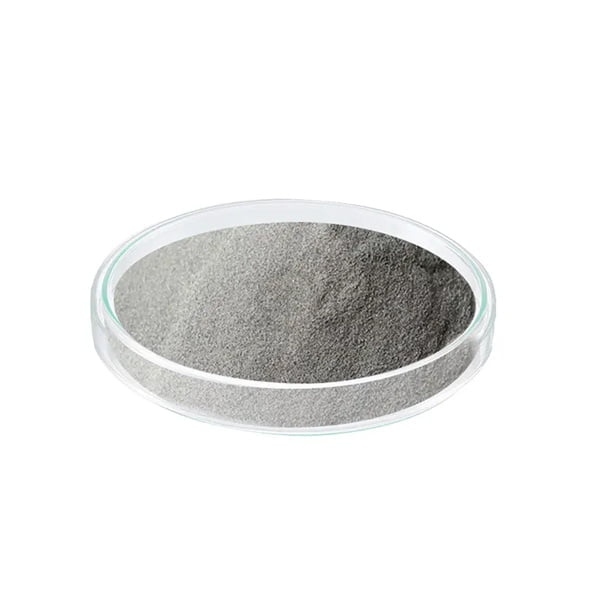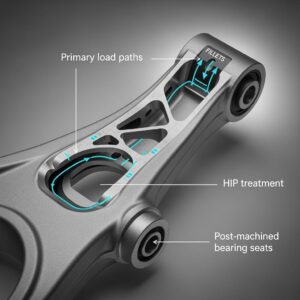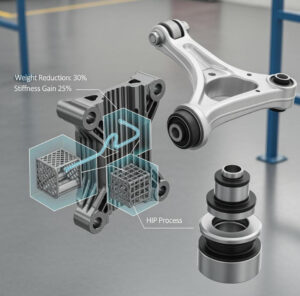3D-utskrift av Inconel 625
Innehållsförteckning
3D-utskrift av Inconel 625 är en nickel-krom-molybdenlegering som kan 3D-printas till högpresterande komponenter för krävande tillämpningar. Den här guiden täcker allt om Inconel 625 för additiv tillverkning.
Översikt över 3D-utskrift med Inconel 625
Inconel 625 är en superlegering som uppvisar:
- Hög hållfasthet och hårdhet vid förhöjda temperaturer
- Utmärkt korrosionsbeständighet
- God svetsbarhet och bearbetbarhet
- Oxidations- och krypbeständighet
Viktiga egenskaper gör den lämplig för 3D-printning av komplexa geometrier med hjälp av pulver:
- Tillgänglig för de viktigaste tryckprocesserna: DMLS, SLM, Binder Jetting
- Möjlighet att trycka på överhäng och interna kanaler
- God måttnoggrannhet och ytfinhet
- Komponenter med hög densitet och fin mikrostruktur
- Egenskaper jämförbara med eller bättre än gjutna och smidda
- Minskning av avfall jämfört med subtraktiv teknik
Inconel 625:s kombination av styrka, duktilitet och korrosionsbeständighet möjliggör lätta, högpresterande tryckta delar i alla branscher.
Sammansättning av Inconel 625
Typisk sammansättning av legeringen Inconel 625:
- Nickel - 58%
- Krom - 20-23%
- Molybden - 8-10%
- Järn - 5% max
- Niob - 3-4%
- Spårmängder av C, Si, P, S
Viktiga legeringselement som krom, molybden och niob ger oxidationsbeständighet vid höga temperaturer, extra hårdhet och utskiljningsförstärkning. Sammansättningen kan justeras baserat på applikationskrav.

Viktiga egenskaper för Inconel 625
Egenskaper hos Inconel 625:
- Densitet - 8,44 g/cm3
- Smältpunkt - 1300°C
- Draghållfasthet - 760-1380 MPa
- Sträckgräns - 550 MPa
- Förlängning - 50%
- Elasticitetsmodul - 200-217 GPa
- Termisk ledningsförmåga - 9,8 W/m-K
- Termisk expansionskoefficient - 12,8 x 10-6 m/m°C
Balansen mellan hög hållfasthet, duktilitet, korrosionsbeständighet och stabila egenskaper vid förhöjda temperaturer gör denna superlegering användbar för krävande applikationer.
Inconel 625-pulver för 3D-utskrift
Viktiga egenskaper hos pulver av Inconel 625 för additiv tillverkning:
Egenskaper för pulver av Inconel 625
- Partikelform - Mestadels sfärisk
- Partikelstorlek - 15-45 mikrometer
- Skenbar densitet - 4 g/cm3
- Flytbarhet - Något sammanhängande
- Renhetsgrad - Nickel + andra legeringsämnen > 99,5%
- Syrehalt - <500 ppm
Sfärisk morfologi och kontrollerad partikelstorleksfördelning ger jämn spridning av pulvret under tryckning. Hög renhet minimerar defekter.
Metoder för 3D-tryckning av Inconel 625
Populära additiva tillverkningsprocesser som är lämpliga för Inconel 625 inkluderar:
3D-utskriftsmetoder för Inconel 625
| Metod | Beskrivning |
|---|---|
| DMLS | Använder laser för att smälta metallpulver |
| SLM | Selektiv lasersmältning av pulver |
| Sprutning av bindemedel | Binder pulver med flytande medel |
| LINS | Laserteknisk nätformning |
| EBM | Smältning med elektronstråle i vakuum |
DMLS och SLM erbjuder hög noggrannhet och ytfinish. Binder jetting är mer ekonomiskt. EBM och LENS bygger större komponenter med nära nätform. Parametrarna måste optimeras för varje process.
Tillämpningar av 3D-tryckta Inconel 625-delar
Industrier som använder additivt tillverkade komponenter av Inconel 625:
Tillämpningar av 3D-tryckt Inconel 625
| Industri | Tillämpningar |
|---|---|
| Flyg- och rymdindustrin | Turbinblad, brännkammare, munstycken |
| Olja och gas | Ventiler och delar till borrhål exponeras för sur gas |
| Kraftproduktion | Slangar till värmeväxlare, pumpaxlar |
| Fordon | Turboladdare, hjul, avgaskomponenter |
| Kemisk bearbetning | Korrosionsbeständiga delar för vätskehantering |
Andra användningsområden är värmesköldar, pressverktyg, kärnreaktorer, sportutrustning och biomedicinska implantat som utnyttjar styrka, duktilitet och biokompatibilitet.
Fördelar med 3D-utskrift av Inconel 625
Viktiga fördelar med additiv tillverkning med Inconel 625:
Fördelar med 3D-utskrift av Inconel 625
- Förmåga att producera komplexa, optimerade geometrier
- Kortare ledtider och lägre kostnader jämfört med maskinbearbetning
- Minskad vikt tack vare topologioptimering
- Mindre spill jämfört med subtraktiv teknik
- Överlägsna materialegenskaper jämfört med gjutning
- Inget behov av dyra verktyg eller matriser
- Konsolidering av underenheter till enskilda delar
- Anpassning och snabb prototypframtagning
3D-printning övervinner begränsningarna med traditionell tillverkning för att tillverka högpresterande Inconel-komponenter.
Begränsningar vid tryckning av Inconel 625
Utmaningar med 3D-utskrift av Inconel 625
- Hög kostnad för pulver av Inconel 625
- Krav på inert gas under tryckning
- Svårigheter att ta bort stödstrukturer
- Efterbearbetning kan behövas för att minska påfrestningarna
- Testning krävs för att kvalificera tryckta delar
- Lägre duktilitet än smidd Inconel 625
- Begränsat antal kvalificerade leverantörer
- Stora delar begränsas av skrivarens byggvolym
Processförfiningar och kvalificeringar kommer att öka användningen av additivt tillverkade Inconel 625-komponenter för verksamhetskritiska applikationer.
Inconel 625 Pulverleverantörer för 3D-utskrift
Välrenommerade leverantörer av Inconel 625-pulver för AM inkluderar:
Leverantörer av Inconel 625 pulver
| Företag | Plats |
|---|---|
| Sandvik | Tyskland |
| Praxair | USA |
| Snickare Tillsats | USA |
| AP&C | Kanada |
| SLM-lösningar | Tyskland |
| LPW-teknik | STORBRITANNIEN |
Dessa företag tillverkar Inconel 625-pulver med hjälp av inertgasatomisering och kontrollerar strikt partikelstorleksfördelning, morfologi, syrehalt och andra kvalitetsattribut.
Materialkostnadsanalys för Inconel 625
Inconel 625 Pulver Kostnad
| Kvantitet | Pris per kg |
|---|---|
| 1-10 kg | $100-150 |
| 10-50 kg | $80-120 |
| >50 kg | $50-100 |
Kostnaden är högre än för pulver av rostfritt stål men lägre än för reaktiva legeringar som titan. Rabatter gäller för bulkbeställningar. Delkostnaden beror också på produktgeometri och bygghastighet.
Jämförande analys av Inconel 625
Jämförelse av Inconel 625 med rostfritt stål och koboltkrom
| Legering | Inconel 625 | 316L rostfritt stål | CoCr-legering |
|---|---|---|---|
| Densitet (g/cm3) | 8.4 | 8.0 | 8.3 |
| Draghållfasthet (MPa) | 1035 | 515 | 655 |
| Smältpunkt (°C) | 1300 | 1370 | 1290 |
| Motståndskraft mot korrosion | Utmärkt | Bra | Rättvist |
| Kostnad | Hög | Låg | Måttlig |
| Utskriftsmöjlighet | Rättvist | Utmärkt | Bra |
Inconel 625 ger bäst prestanda vid höga temperaturer men har högre materialkostnader. Rostfritt stål är lättare att trycka och billigare. Koboltkrom ger en balans för dentala och medicinska användningsområden.

Vanliga frågor
F: Vilken partikelstorlek är optimal för 3D-utskrift av Inconel 625?
A: Ett partikelstorleksintervall på 15-45 mikron rekommenderas, med en sfärisk morfologi och tät fördelning för optimal flytbarhet och hög packningstäthet under tryckning.
F: Vilken tryckprocess är bäst lämpad för Inconel 625?
A: DMLS och SLM med hjälp av en högeffektslaser ger bästa noggrannhet, densitet och ytfinish. Binder jetting ger snabbare bygghastigheter men lägre mekaniska egenskaper.
F: Kräver Inconel 625 värmebehandling efter 3D-utskrift?
S: Ja, en värmebehandlingscykel med lösglödgning och åldring utförs ofta för att minska spänningar och uppnå optimal duktilitet, styrka och andra mekaniska egenskaper.
F: Vilka branscher använder 3D-tryckt Inconel 625 mest?
S: Flyg- och rymdindustrin är den största användaren av förbränningskomponenter. Olja och gas, kraftgenerering, fordonsindustri och kemisk bearbetning använder också 3D-tryckt Inconel 625.
F: Är det möjligt att 3D-printa delar av Inconel 625 med funktionell gradering?
S: Ja, voxelkontrollmetoder möjliggör kontinuerligt varierande sammansättningar och mikrostrukturer inom en enda tryckt del genom exakt pulverblandning och lasermodulering.
F: Kräver Inconel 625 varm isostatisk pressning efter additiv tillverkning?
S: Även om HIP kan eliminera inre hålrum och förbättra utmattningshållfastheten, gör de senaste processförbättringarna det nu möjligt att uppnå full densitet under tryckningen för de flesta tillämpningar.
F: Vilka efterbehandlingsprocesser används på tryckt Inconel 625?
S: Tryckta delar genomgår ofta abrasiv trumling, shot peening, slipning och polering för att släta ut ytor och ta bort stöd. Varm isostatisk pressning kan också tillämpas.
F: Är materialegenskaperna hos 3D-tryckt Inconel 625 jämförbara med smidda material?
S: Korrekt tryckt och bearbetad Inconel 625 kan matcha och till och med överträffa draghållfasthet, duktilitet, brottseghet och andra egenskaper hos konventionellt bearbetade smideslegeringar.
F: Vilka konstruktionsaspekter gäller för AM-delar av Inconel 625?
S: Fina funktioner kräver tjockare väggar. Konstruktioner bör undvika överhäng, minimera stöd och ta hänsyn till termiska påfrestningar. Moduler kan sammanfogas till monolitiska komponenter.
få veta mer om 3D-utskriftsprocesser
Vanliga frågor och svar (FAQ)
1) What powder specifications matter most when 3D Printing Inconel 625?
- Spherical morphology, PSD 15–45 µm (LPBF), O ≤0.06–0.10 wt%, N ≤0.03 wt%, low satellites, Hall/Carney flow within spec, and consistent apparent/tap density. These drive spreadability, density, and defect control.
2) What post-processing sequence is recommended for high-reliability parts?
- Typical route: stress relief → HIP (optional but recommended for fatigue/leak-critical parts) → solution anneal (~1,150–1,200°C) → rapid quench → aging if required by spec → machining/finishing → NDT (CT/dye pen) and mechanical qualification.
3) How does Inconel 625 compare to 718 for AM?
- 625: solid-solution strengthened, excellent corrosion and weldability, easier to process with less cracking, lower high-temp strength than 718. 718: precipitation strengthened, higher strength at 650–700°C but more complex heat treatment and cracking sensitivity.
4) What build strategy reduces porosity and keyholing in LPBF?
- Maintain moderate volumetric energy density, use contour scans, optimize hatch spacing, ensure high-purity inert atmosphere (O2 <100 ppm), and validate with melt pool monitoring and density checks (Archimedes + CT for critical parts).
5) Can powder be reused without degrading performance?
- Yes, if controlled: sieve between builds; monitor O/N/H, PSD drift, and flow; set reuse limits and blend with virgin to maintain interstitial/spec targets. Track exposure time and keep powder under dry, high-purity argon.
2025 Industry Trends
- Certified process parameter sets: OEMs release 625 PBF-LB recipes targeting near-zero lack-of-fusion with improved contour strategies and gas flow mapping.
- Corrosion-first applications: Increased adoption in offshore wind, geothermal, and sour-service components where 625 outperforms 718 in chloride/sulfide media.
- Data-rich CoAs: Routine inclusion of raw PSD files, SEM morphology, O/N/H trends, and powder exposure logs to accelerate PPAP/FAI.
- Sustainability focus: Powder take-back/reconditioning programs and argon recirculation cut total cost of ownership.
- Binder jetting maturation: Finer 625 cuts (5–25 µm) and advanced sinter profiles improve density for non-pressure-retaining parts.
2025 Snapshot: 3D Printing Inconel 625 KPIs
| Metric (2025e) | Typical Value/Range | Notes/Source |
|---|---|---|
| LPBF PSD | D10 15–20 µm; D50 25–35 µm; D90 40–50 µm | ISO/ASTM 52907 context |
| Oxygen (AM-grade) | ≤0.06–0.10 wt% | Supplier CoAs |
| As-built relative density | ≥99.5% with tuned parameters | CT verification |
| Post-HIP density | ≥99,9% | Leak- and fatigue-critical |
| Typical UTS (post-HT) | ~800–1,000+ MPa | Process/spec dependent |
| Price band (powder) | ~$60–$150/kg (spec/region/volume) | Market quotes |
| Ledtid | 3–7 weeks stocked; 8–12 weeks MTO | Supplier disclosures |
Authoritative sources:
- ISO/ASTM 52907; ASTM F3049 (powder characterization): https://www.astm.org, https://www.iso.org
- AMS 5666/5599 and ASTM B443/B446 (alloy forms/heat treatment guidance)
- ASM Handbook, Vol. 7: Powder Metallurgy; Vol. 13A Corrosion: https://www.asminternational.org
- AMPP/NACE sour-service guidance: https://www.ampp.org
Latest Research Cases
Case Study 1: LPBF Inconel 625 Heat Exchanger with Topology Optimization (2025)
- Background: A geothermal OEM needed compact, corrosion-resistant exchangers with reduced pressure drop.
- Solution: Printed 625 using LPBF with optimized lattice channels; high-purity argon (O2 <50 ppm), contour + remelt strategy; HIP → solution anneal; internal surface finishing via abrasive flow machining.
- Results: Relative density 99.9% post-HIP; pressure drop −21% vs. machined design; ASTM G28 Method A corrosion rate matched wrought baseline; production lead time −38%.
Case Study 2: Binder-Jetted 625 Impellers for Chemical Pumps (2024/2025)
- Background: A chemical processing firm sought spare-part agility for corrosive services.
- Solution: Adopted 5–25 µm 625 powder, solvent debind + high-temp sinter in H2/N2-controlled atmosphere; selective HIP for pressure-retaining variants; final machining of sealing surfaces.
- Results: Achieved 96–98% density as-sintered; HIPed parts ≥99.8%; lifecycle cost −15% with on-demand spares; cavitation performance on par with cast 625 after surface finishing.
Expertutlåtanden
- Dr. John A. Slotwinski, Additive Manufacturing Metrology Expert (former NIST)
- Viewpoint: “For 3D Printing Inconel 625, density is necessary but not sufficient—monitoring interstitials and PSD tails across reuse cycles is critical to assure repeatable mechanicals.”
- Prof. Tresa M. Pollock, Distinguished Professor of Materials, UC Santa Barbara
- Viewpoint: “Contour control and heat management mitigate keyholing and microsegregation in 625; pairing with HIP enables fatigue performance competitive with wrought.”
- Dr. Christina Bertulli, Director of Materials Engineering, EOS
- Viewpoint: “Data-rich CoAs and validated process maps shorten qualification for 625 beyond aerospace—especially in energy and chemical sectors.”
Practical Tools/Resources
- Standards: ISO/ASTM 52907; ASTM F3049; relevant AMS specs (e.g., AMS 5666 for heat treat guidance); ASTM E8/E18 for tensile/hardness
- Corrosion testing: ASTM G28 (intergranular corrosion in Ni-Cr-Mo alloys); ASTM G48 (pitting); ASTM G31 immersion tests
- Metrology: Inert gas fusion (O/N/H), laser diffraction (PSD), SEM for morphology, CT for porosity, in-situ melt pool monitoring
- Process control: Gas purity monitors (O2 <100 ppm), powder reuse SOPs, exposure time logging, SPC on density/mechanicals
- Design/simulation: Ansys/Simufact Additive for distortion and support optimization; topology optimization tools for weight reduction
Implementation tips:
- Specify CoA with chemistry incl. interstitials, PSD (D10/D50/D90), morphology images, flow/tap/apparent density, and lot genealogy.
- Use tuned LPBF parameters with contour + remelt; validate density via CT for pressure-retaining parts.
- Plan HIP for fatigue- and leak-critical applications; follow with solution anneal and required finishing.
- For corrosive service, confirm performance with ASTM G28/G48 testing and surface finish controls on wetted geometries.
Last updated: 2025-10-13
Changelog: Added focused 5-question FAQ, 2025 KPI table, two recent case studies (LPBF heat exchanger and binder-jetted impellers), expert viewpoints, and practical tools/resources with implementation tips for 3D Printing Inconel 625
Next review date & triggers: 2026-04-20 or earlier if ISO/ASTM/AMS standards update, major supplier CoA practices change, or new data on HIP effects and powder reuse for Inconel 625 AM is published
Dela på
MET3DP Technology Co, LTD är en ledande leverantör av lösningar för additiv tillverkning med huvudkontor i Qingdao, Kina. Vårt företag är specialiserat på 3D-utskriftsutrustning och högpresterande metallpulver för industriella tillämpningar.
Förfrågan för att få bästa pris och anpassad lösning för ditt företag!
Relaterade artiklar

Metal 3D Printing for U.S. Automotive Lightweight Structural Brackets and Suspension Components
Läs mer "Om Met3DP
Senaste uppdateringen
Vår produkt
KONTAKTA OSS
Har du några frågor? Skicka oss meddelande nu! Vi kommer att betjäna din begäran med ett helt team efter att ha fått ditt meddelande.













